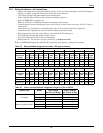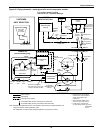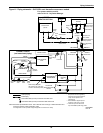
Piping
80
8.3.2 Air-Cooled Condenser with Lee-Temp “Flooded Condenser” Head Pressure Control
System
The Lee-Temp system consists of a modulating type head pressure control valve and insulated receiv-
ers with heater pads to ensure operation at ambient temperatures as low as -30°F (-34.4°C).
Lee-Temp Piping
Two discharge lines and two liquid lines must be field-installed between the indoor unit and the out-
door condenser. See Figures 57 and 59 for details.
Lee-Temp Controlled Materials Supplied
•Built-in, pre-wired condenser control box
• Air-Cooled condenser
• Piping access cover to be reinstalled when piping is complete
• Bolts—four per leg (3/8" x 5/8")
• Terminal block for two-wire, 24V interlock connection between unit and condenser
• Condensate legs—four with 1-fan, six on two-and three-fan models and eight on four-fan models
• Bolts—six per receiver (3/8" x 1")
• Lee-Temp system:
• Insulated storage receiver—one per circuit
• Head pressure control valve with integral check valve - one per circuit
• Service valve—one per circuit
• Pressure relief valve—one per circuit
• Liquid level sight glass—two per circuit
• Check valve—one per circuit
Lee-Temp Leak Check and Evacuation Procedure
Proper leak check and evacuation can be accomplished only with all system solenoid valves open and
check valves accounted for.
1. If unit power is available, open the unit liquid line solenoid valves using the evacuation function
for System #1 and System #2 in the diagnostic section of the iCOM control. If unit power is not
available, a field-supplied 24VAC / 75VA power source must be directly connected to each of the
unit solenoid valves.
2. Attach a jumper hose from the service valve fitting on the outlet of the receiver and the Schrader
fitting on the discharge header of the condenser. Front-seat the service valve approximately
two (2) turns.
3. For semi-hermetic compressors, connect refrigeration gauges to the suction and discharge service
valves of both compressors.
4. For scroll and digital scroll compressors, connect refrigerant gauges to the suction rotalock valves
and discharge line Schrader valves (see Note above) on both compressors.
5. Starting with Circuit #1, open the service valves and place a 150 PSIG (1034 kPa) of dry nitrogen
with a tracer of refrigerant. Check system for leaks with a suitable leak detector.
6. With pressure still in Circuit #1, open the compressor service valves in Circuit #2. If pressure
increases in Circuit #2, the system is cross-circuited and must be rechecked for proper piping. If
there is no pressure increase, repeat the leak check procedure for Circuit #2.
7. After completion of leak testing, release the test pressure (per local code) and pull an initial deep
vacuum on the system with a suitable pump.
NOTE
Lee-Temp heater pads require a separate, continuous electrical source. See nameplate on unit
for proper voltage.
NOTE
Systems with scroll or digital scroll compressors include a factory-installed check valve and an
additional downstream Schrader valve with core in the compressor discharge line. Proper
evacuation of the condenser side of the compressor can be accomplished only using the
downstream Schrader valve. See piping schematic (Figure 59).


















